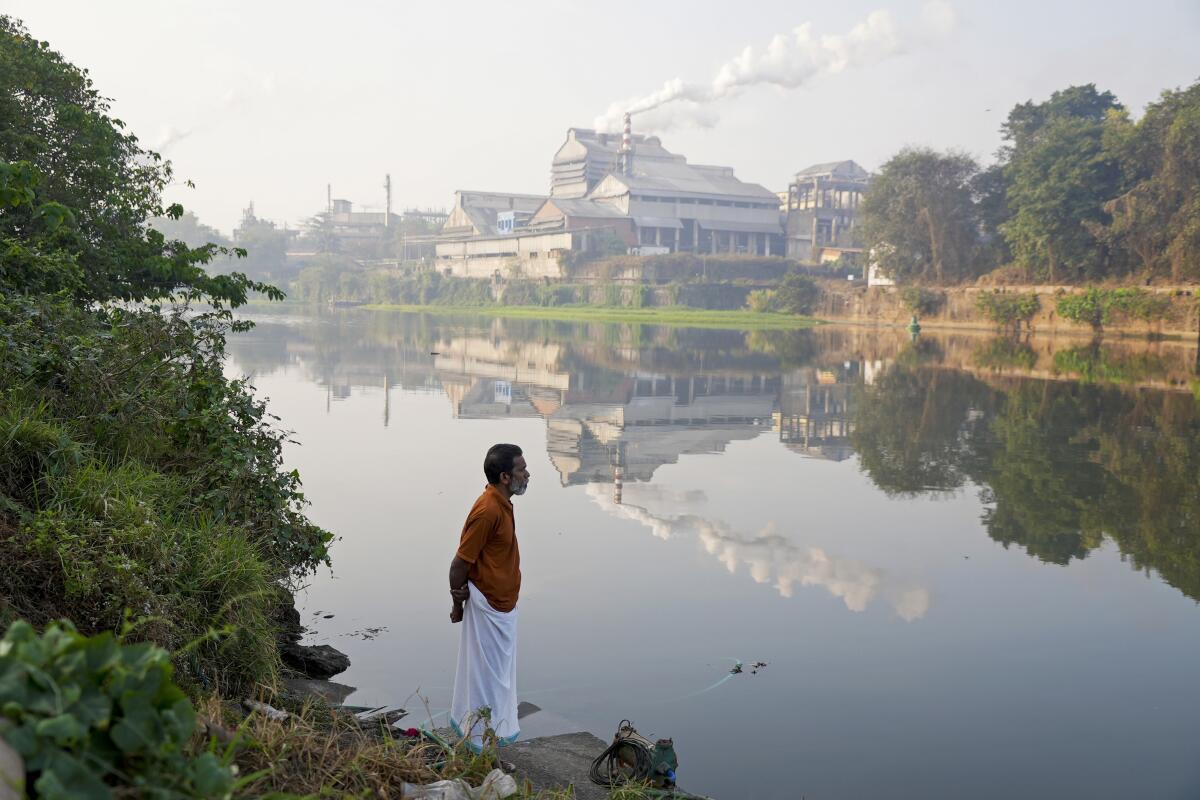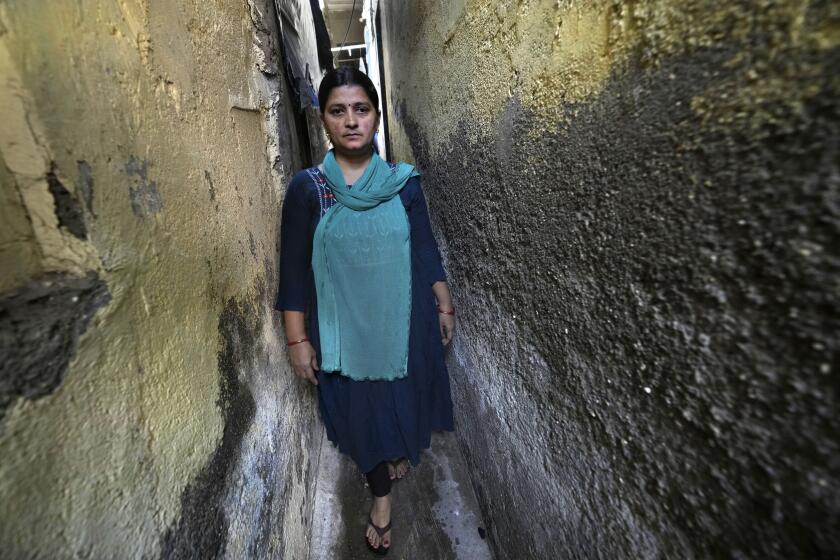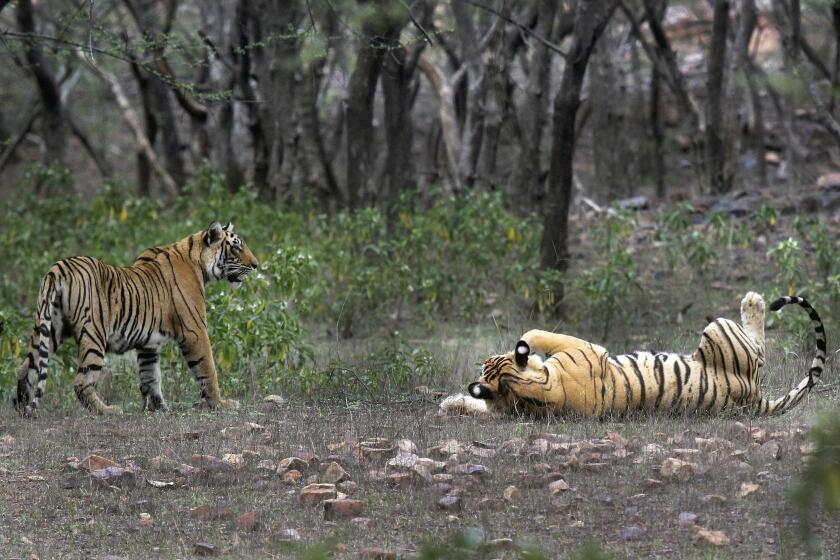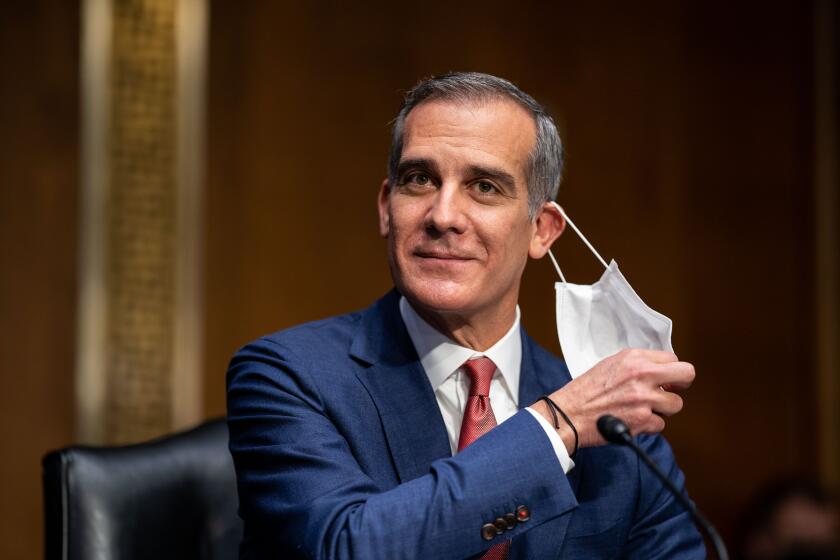India residents try to save a river, officials deny problems

- Share via
KOCHI, India — Eloor smells like it is dying.
Once it was an island of rich farmland on the Periyar River, 10.5 miles from the Arabian Sea, teeming with fish. Now, a stench of putrid flesh permeates the air. Most of the fish are gone. Locals say even people living near the river are hardly having children anymore.
Yet here is Shaji, alone in his small fiber boat, fishing with his handmade rod, massive industrial smokestacks behind him.
About 300 chemical companies belch out dense fumes in this part of south India’s Kerala state, almost warning people to stay away. The waters have taken on dark hues. Shaji, a fisherman in his late 40s who uses only one name, is among the few who remain.
“Most of the people here are trying to migrate from this place. If we look at the streets, it’s almost empty. There are no jobs, and now we cannot even find work on the river,” said Shaji, displaying the few pearl spot fish he managed to catch during an entire day in March.
Many of the petrochemical plants here are more than five decades old. They produce pesticides, rare earth elements, rubber-processing chemicals, fertilizers, zinc-chrome products and leather treatments.
India will soon eclipse China to become the world’s most populous country, and its economy is among the fastest-growing.
Some are government-owned, including Fertilisers & Chemicals Travancore, established in 1943, Indian Rare Earths Ltd. and Hindustan Insecticides Ltd.
Residents say the industries take in large amounts of freshwater from the Periyar and discharge concentrated wastewater with almost no treatment.
Anwar C.I., who uses initials for his last name in the custom of southern India, is a member of a Periyar antipollution committee and a private contractor who lives in the area. He said residents have grown accustomed to the reek that seems to hang over the area like a heavy curtain, enveloping everything and everyone.
The groundwater is now fully contaminated, and the government’s contention that the businesses benefit people is wrong, he said.
“When they claim to provide employment to many people through industrialization, the net impact is that the livelihood of thousands is lost,” Anwar said. People cannot make a living from ruined land and water.
Residents have periodically risen up against the factories in the form of protests. Demonstrations began in 1970, when the village first witnessed thousands of fish dying. Die-offs and protests happened again many times after that, said Shabeer Mooppan, a longtime resident who has often demonstrated.
“Some of the early protest leaders are now bedridden” in advanced age, Mooppan said, emphasizing just how long people in the community have been trying to get the river cleaned up.
Demographers are unsure exactly when India will take the title as the most populous nation in the world because they’re relying on estimates.
Now Mooppan is trying to improve surveillance to catch those responsible for fouling the river. It’s a method used by river keepers and bay keepers in cities around the world. He is also pursuing legal cases against polluting industries.
The state Pollution Control Board downplayed the industrial pollution in the Periyar River, instead blaming sewage from homes, commercial institutions and markets upstream.
“We have not found any alarming rate of metals in the river water. All the levels are within the limits,” said Baburajan P.K., chief environmental engineer of the board.
Baburajan said that only five major companies in the region are allowed to discharge wastewater into the river, and that it must be treated. The rest must treat their wastewater, reusing or disposing it on their land. He said hefty environmental levies have been imposed on violators.
Research also tells a story of a river in distress.
As far back as 1998, scientists at the Kerala University of Fisheries and Ocean Studies found about 25 species of fish had disappeared from the region. Experts have found contamination in vegetables, chicken, eggs, fruits and tuber crops.
Wildlife conservation initiatives, including Project Tiger, have forced Indigenous people out of forests and hurt their livelihoods, protesters say.
Chandramohan Kumar, a professor in Chemical Oceanography at Cochin University of Science and Technology, has researched Periyar River pollution in several studies.
“We have observed pollution from various organic fertilizers, metallic components. Toxic metals like cadmium, copper, zinc and all the heavy metals can be detected there,” Kumar said.
India has a special environmental court called the National Green Tribunal. A decade ago, it ordered the government to create a plan to restore water quality in the river to protect the environment and public health. It also ordered the formation of a monitoring committee.
More recently, the tribunal was worried enough to initiate its own proceeding on the pollution. It cited studies going back to 2005, carried out by the environmental nonprofit Thanal, that showed “hundreds of people living near Kuzhikandam Creek at Eloor were afflicted with various diseases such as cancer, congenital birth defects, bronchitis, asthma, allergic dermatitis, nervous disorders and behavior changes.”
The court cited another survey, of 327 families, that showed hazardous chemicals, including DDT, hexachlorochyclohexane, cadmium, copper, mercury, lead, toluene, manganese and nickel, had been discharged into Kuzhikandam Creek “and adversely affected the health condition of people in Eloor.”
Kumar said that the remedy for this pollution is on-site treatment at each facility and that it comes down to money. “If they are ready to invest, the effluent discharge can be resolved,” he said.
The Los Angeles mayor’s approval was expected, and his nomination now heads to the Senate, where it requires a simple majority vote.
The Pollution Control Board responded that it recently began a study that could lead to curbing air pollution and reducing the intolerable stench in the area largely caused, it said, by bone meal fertilizer factories and meat rendering plants. It is expected to be finalized in May.
The board dismissed allegations that it does not pursue polluters and said it ensures no untreated waste liquids are discharged into the river.
Trainees with the Pollution Control Board do daily trips to collect samples from six points along the river.
“But we don’t know what happens to those samples,” resident Adam Kutty said. “What’s the point of having all the money in the world and no water to drink?”
Omana Manikuttan, a longtime resident, said that for years she and her neighbors have not eaten fish from the river. Eating them leads to serious diarrhea, and they taste like pesticides, even after cooking, Manikuttan said.
As the blame game continues, the grass and trees in the area appear wilted as if scorched by the noxious fumes. The birds seem to have been driven away by the air. Without official action, the pall over the region and its residents is unlikely to lift soon.
More to Read
Sign up for Essential California
The most important California stories and recommendations in your inbox every morning.
You may occasionally receive promotional content from the Los Angeles Times.

















